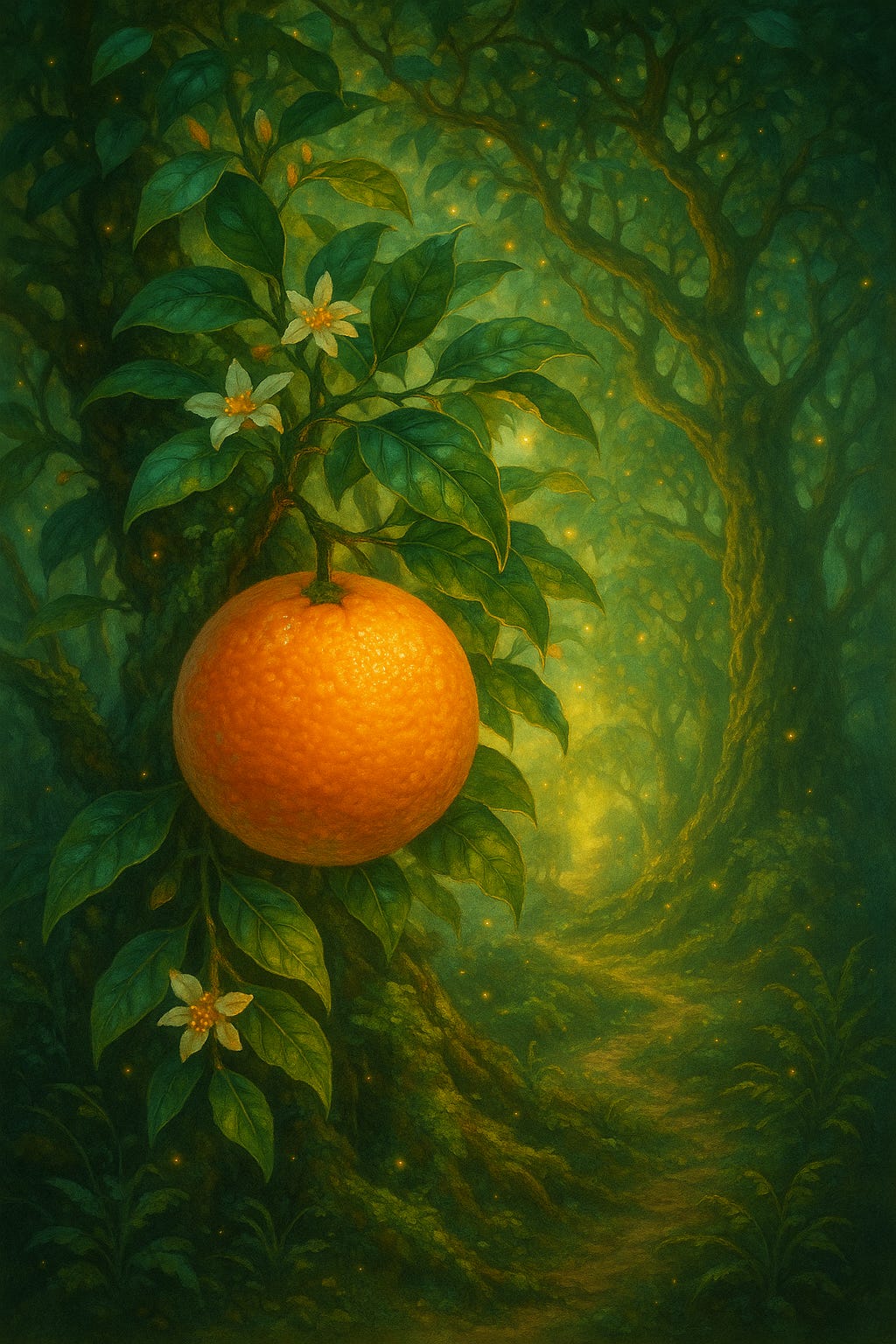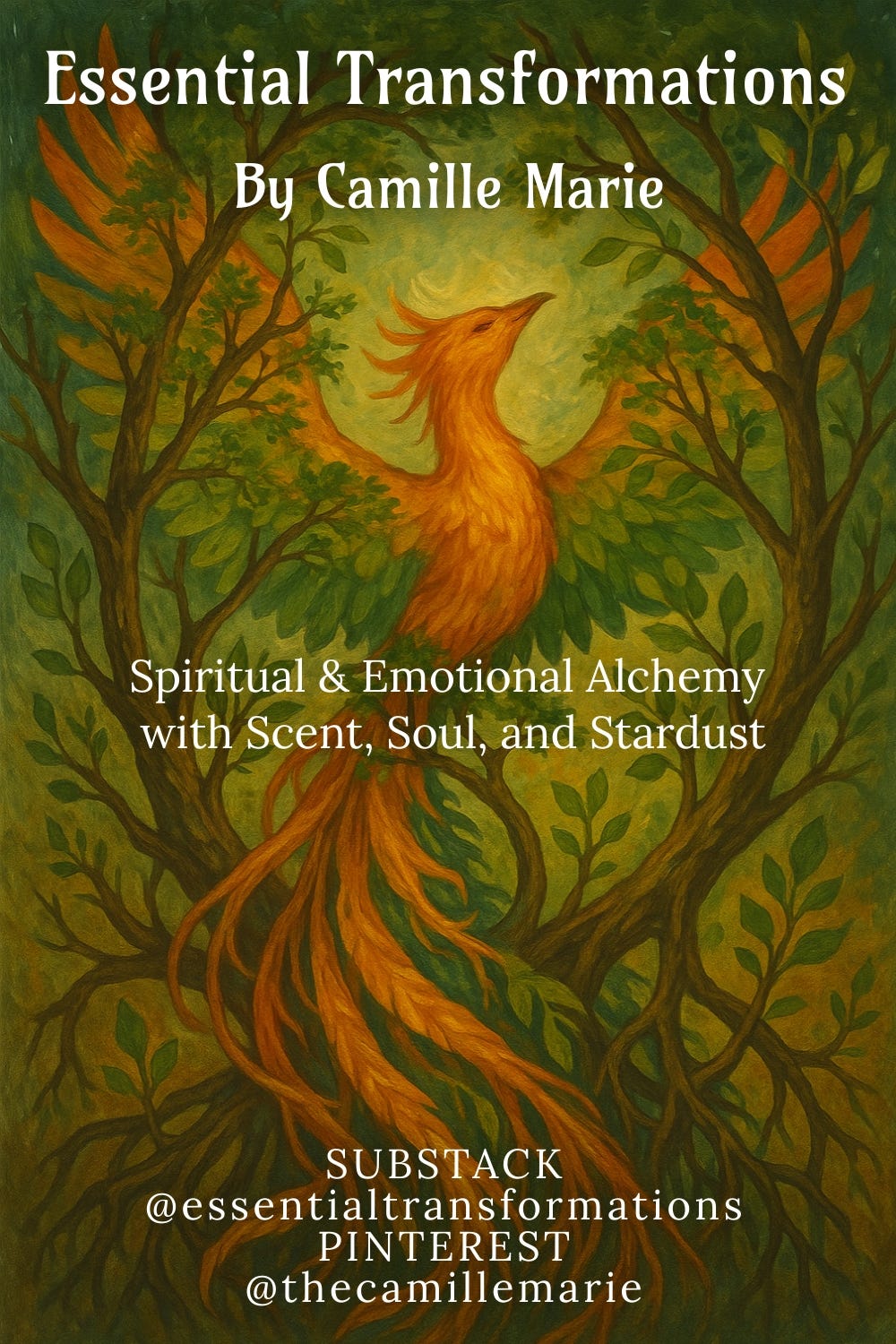Orange Tree Essential Oil - Part 1, Foundation
Harmonious Fusion
Orange - 2 Species, 3 Oils
This will be a multi-part series dedicated to the oils derived from the various parts of the orange tree.
In this first article, you’ll learn about the 3 types of oils made from the orange tree, the 2 species used for the oils, and a little about the origin of the fruit. (Spoiler alert—the orange was born around the time of Jesus!) This will give you a foundation into the technicalities before we delve into the energetics.
Why is this important? The source of each oil—as well as the properties of the tree itself—impacts the aroma and the energetic properties. Keep reading to learn more.
3 Oils from the Orange Tree
Here are the three types of orange tree oils and their corresponding source:
Orange oil — made from the rind (also labeled as wild orange or sweet orange). Rinds are protective. They shield the fruit from predators and the elements. Oils from fruit rinds can be used for protection. The rind is also part of the fruit, which represents the natural abundance and manifestation power of the tree. Oils from fruit can also be used for abundance and manifestation.
Neroli oil — made from the flowers. Flowers are associated with love, sensuality, fertility, and creativity. Any flower oil can be used with these properties in mind.
Petitgrain oil — made from the leaves (and twigs). Leaves are associated with growth and nourishment. If you have a project that you are trying to get started or expand, it could benefit from intentions set with leaf oil.
As you work with these beauties, keep in mind the energetics of their oil source. They add a nice layer of nuance to your intention rituals.
Now that you know about the oils available from an orange tree, let’s look at the two different species used by the aromatherapy industry: Citrus sinensis (sweet orange) and Citrus aurantium (bitter orange).
Species #1 - Sweet Orange - Oil from the Rind
Citrus sinensis is the most popular type of orange. It’s also known as the sweet orange. It’s the one you’ll encounter in the grocery store, hotel buffet, or airplane. Navel and Valencia oranges are both from the Citrus sinensis species.
It’s also the type of orange used for essential oil cold pressed from the rind. When you’re craving the bright, uplifting scent associated with freshly squeezed orange juice, this is the oil you want.
Sweet Orange vs Wild Orange vs Orange - what the heck is the difference?
Whether your bottle of orange essential oil is labeled as sweet orange, wild orange, or regular generic orange, it will likely be from the rind of Citrus sinensis. Check the Latin name on the bottle to be sure.
The difference between sweet orange and wild orange is the sourcing and aroma. Sweet orange comes from traditional, agriculture-based farms. (The same is true for regular, generic orange oil.) Wild orange is from wildcrafted or semi-wild groves. Wild orange will be a little stronger and tangy in the aroma.
Species #2 - Bitter Orange - Oil from Flower & Leaves/Twigs
Citrus aurantium is also known as bitter orange. The most common type is the Seville. It’s used to make marmalade and liqueurs such as Grand Marnier and Cointreau. (Um, yes please to all those!)
The bitter orange, due to its sour taste, is not a common grocery store find, especially where sweet oranges dominate the market. If you want to taste one, you might try a specialty grocery store or a farmer’s market in marmalade season (late winter). They are found more readily in the UK, where marmalade is popular.
The bitter orange is where you get neroli (flower) and petitgrain (leaves and twig). The oils reflect the vastly different flavor profile of the bitter orange, creating oils that are pungent and “green” in their aromas.
Hybrid - Harmonious Fusion
Did you know the orange is a hybrid? Arguably the world’s most popular fruit with approximately 375 billion oranges produced and sold each year, it’s a hybrid of pomelo and mandarin. Genetic studies indicate the hybridization happened 2,000 years ago somewhere in Asia. This means the orange appeared around the time of Jesus. Isn’t that cool?
Hybrid energy is really fascinating, especially when considering the pervasive staying power of something like an orange. It’s fair to say the orange is larger (much larger!) than the sum of its mandarin and pomelo parts. The separate identities of the pomelo and mandarin are lost in the hybridization.
You can use the powerful hybrid energy of the orange when you’re seeking to create something bigger and bolder than the sum of its parts. Think of it as transformation through integration.
Here are some ideas on real-world application of transformation through integration energy:
Collaborative creative projects involving 2 or more people, like a podcast or vacation planning.
Merging of preexisting entities. Think blended families or company mergers.
Relationship alchemy, when you and your partner seek to create something greater than the sum of your parts. This could be merging funds to buy a house, or choosing to start a family.
If invoking hybrid energy with orange oil, consider with caution the loss of the separate identities that comes with this type of fusion. For example, it might not be ideal to lose your individual identity in a romantic relationship. Yet it might be perfect for the merging of two businesses, especially if you want them to function cohesively as a unique, new expression.
Just something to keep in mind as you call on hybrid energy for harmonious fusion.
What is your favorite type of orange essential oil? What do you like to use it for? Let me know in the comments, or hit reply if you are reading this in email form.
Where to get Orange Essential Oil
Wild orange, sweet orange, neroli, and petitgrain are all available at my favorite oil shop, Revive EO. You can try wild orange and sweet orange and compare their different aromas. (Which is, of course, the first thing I did when I bought them!) Neroli is pretty pricey due to the large volume of flowers needed to make the oil, but Revive sells it in a 2.5 ml bottle that makes it affordable.
Thanks for Reading!
I very much appreciate you being here and reading this publication. If you enjoy it, please subscribe and share!
Keep Alchemizing,
Camille Marie



Thanks for the restack!
Oooh, I love this!!